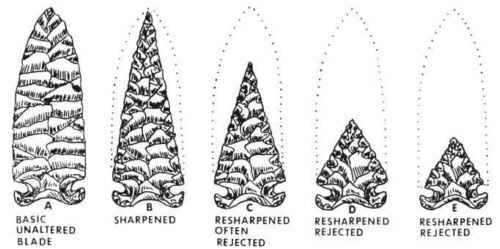|
two" (Painter, 1983 ) . No archaeologist would have dared say that three years ago.
To archaeologists and collectors alike, the Hardaway Side-Notched projectile point is a broad, short point with a steeple-shaped blade, and it is true that 95% of those found on habitation sites fit that description. The first published photograph (Wormington, 1957) of a Hardaway Side-Notched point is of that type, as are all the specimens shown in Coe ( 1964, p. 68) . This has become considered the classic type and when the name is mentioned the mind depicts a broad, short, steeple-shaped lineation with a ram’s-horned base.
The above described projectile point (the so-called classic type) is in all actuality a many-times resharpened and rejected version of the unaltered or unresharpened basic type. In short, it was considered a bit of worn-out, unusable trash by it aboriginal owner (Painter, l982). Having been resharpened so many times that it became too short, and blunt to be effective as a weapon or tool.

FIG. 9: REWORKED BLADE STAGES.
Resharpened, rejected projectile points are the hallmark of the Hardaway Tradition. From the earliest known type of the Hardaway Tradition (the Haw River) to the latest or descendent specimens of the Early Archaic (Painter, 1982) this lithic trait is apparent on habitation sites. To the people of the Hardaway Tradition, a projectile point served as a "Swiss Army- Knife", it was used as a multi-purpose tool. It served as a knife, saw, scraper, drill, graver and gouge, in addition to its basic purpose. It could be resharpened or altered to suit specific needs without, being detached from a foreshaft while on a hunting foray. After returning from the hunt, all no longer useful or broken points were removed from the foreshaft and replaced with new blades such as specimen "A" in Figure 9 above. The many times altered or resharpened and rejected specimens such as "D","E" and sometimes "C", were tossed aside and

